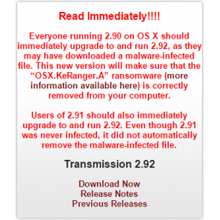KeRanger
KeRanger (also known as OSX.KeRanger.A) is a ransomware trojan horse targeting computers running macOS. Discovered on March 4, 2016, by Palo Alto Networks, it affected more than 7,000 Mac users.
KeRanger is remotely executed on the victim's computer from a compromised installer for

Discovery
On March 4, 2016, Palo Alto Networks added Ransomeware.KeRanger.OSX to their virus database. Two days after, they published a description and a breakdown of the code.
Propagation
According to
The only way the malware infected the victim's computer was by using a valid developer signature issued by Apple, which allowed it to bypass Apple's built-in security.
Encryption process

The first time it executes, KeRanger will create three files ".kernel_pid", ".kernel_time" and ".kernel_complete" under ~/Library directory and write the current time to ".kernel_time". It will then sleep for three days.
KeRanger encrypts each file (e.g. Test.docx) by first creating an encrypted version that uses the .encrypted extension (i.e. Test.docx.encrypted.) To encrypt each file, KeRanger starts by generating a random number (RN) and encrypts the RN with the RSA key retrieved from the C2 server using the RSA algorithm. It then stores the encrypted RN at the beginning of resulting file. Next, it will generate an Initialization Vector (IV) using the original file’s contents and store the IV inside the resulting file. After that, it will mix the RN and the IV to generate an AES encryption key. Finally, it will use this AES key to encrypt the contents of the original file and write all encrypted data to the result file.
Encrypted files
After connecting to the C2 server, it will retrieve the encryption key, then start the process. It will first encrypt the "/Users" folder, then after that "/Volumes" There are also 300 file extensions that are encrypted, such as:
- Documents: .doc, .docx, .docm, .dot, .dotm, .ppt, .pptx, .pptm, .pot, .potx, .potm, .pps, .ppsm, .ppsx, .xls, .xlsx, .xlsm, .xlt, .xltm, .xltx, .txt, .csv, .rtf, .te
- Images: .jpg, .jpeg
- Audio and video: .mp3, .mp4, .avi, .mpg, .wav, .flac
- Archives: .zip, .rar., .tar, .gzip
- Source code: .cpp, .asp, .csh, .class, .java, .lua
- Database: .db, .sql
- Email: .eml
- Certificate: .pem
References
- ^ a b Xiao, Claud; Chen, Jin (6 March 2016). "New OS X Ransomware KeRanger Infected Transmission BitTorrent Client Installer - Palo Alto Networks Blog". Palo Alto Networks Blog. Retrieved 2016-03-10.
- ^ "KeRanger Is Actually A Rewrite of Linux.Encoder". Bitdefender Labs. Retrieved 28 March 2016.
